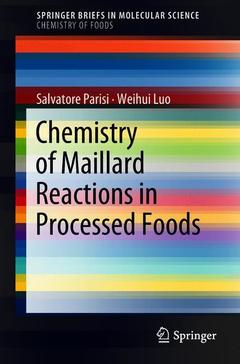Description
Chemistry of Maillard Reactions in Processed Foods, 1st ed. 2018
Chemistry of Foods Series
Authors: Parisi Salvatore, Luo Weihui
Language: English
Subjects for Chemistry of Maillard Reactions in Processed Foods:
52.74 €
In Print (Delivery period: 15 days).
Add to cartSupport: Print on demand
Description
/li>Contents
/li>Biography
/li>Comment
/li>
While under the right conditions Maillard reactions have many favorable effects (e.g. formation of antioxidants), the Brief discusses that there are also conditions where Maillard reactions can result in toxic or mutagenic reactions. Hence, it emphasizes that the reaction should be viewed as a complex network of various sub-reactions, with a plethora of concomitant reaction mechanisms and kinetics. This Brief thus makes a step toward a holistic evaluation of the complexity of the Maillard reaction scheme, with the aim of making better and more targeted use in food processing.
The Importance of Maillard Reaction in Processed Foods.- Maillard Reaction in Processed Foods: Reaction Mechanisms.- Maillard Reaction and Processed Foods: Main Chemical Products.
Salvatore Parisi, PhD, FSPCA PCQI, obtained his MSc from the University of Palermo, and PhD from the University of Messina, Italy. Between 1994 and 2010, Dr Parisi has been involved in different chemical activities working and travelling in different countries around the world, including the United Kingdom, Spain, France, Czech Republic, and United States of America. Dr. Parisi serves as series editor for the SpringerBriefs in Molecular Science: Chemistry of Foods; he is also an associate of AOAC International, USA, Southern California Section, serving in the AOAC Official Methods of AnalysisSM (OMA) Expert Review Panel (ERP) for Fertilizers, the AOAC SPIFAN ERP for 2- and 3-MCPD & Glycidyl Esters, and eight different AOAC working groups. He also co-authored the “Stakeholders’ Guidance Document for Consumer Analytical Devices with a Focus on Gluten and Food Allergens”, recently published in the Journal of AOAC International. More recently, He has served as Special Guest Editor for the Journal of AOAC International in 2018 with a Section concerning antibiotics and antimicrobials in foods. At present, he is actively working at the Associazione ‘Componiamo il Futuro’ (COIF), Palermo, Italy.
Weihui Luo is an analytical chemist working in food and non-food products and services. She studied at Fudan University with the final Bachelor in Applied Chemistry in 2008; subsequently, Weihui obtained the American Society for Quality (ASQ) certification as quality engineer in 2014 with peer recognition of her proficiency in quality control and quality assurance areas. After six years in different roles concerning analytical chemistry, Weihui worked as laboratory manager at Quo Qi Lab, Shanghai, China, until 2017. At present, she works at Kangdexin (KDX) Composite Material Group, China. Her expertise includes quantitative chemical analysis of organic and metal pollutants in water and soil by chromatography and spectroscopy, and analyses in processed
Explains the importance of Maillard reactions for the food processing industry
Characterizes typical chemical reaction products, from beneficial to adverse substances
Emphasizes the diversity of Maillard reactions, an entire set of non-enzymatic browning reactions in food products




